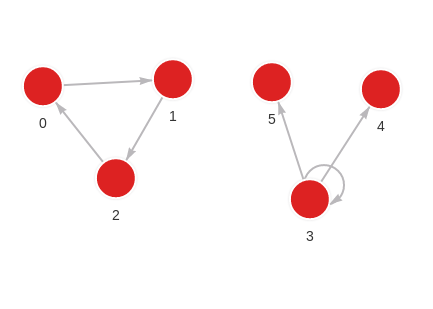union_find
Analysis of connected components is a common task in graph analytics.
By using a disjoint-set data structure that keeps track of them, the algorithm implemented in this module enables the user to quickly check whether a pair of given nodes is in the same or different connected component. A check on a pair of nodes is effectively executed in O(1) time.
The implementation of the disjoint-set data structure and its operations uses the union by rank and path splitting optimizations described in "Worst-case Analysis of Set Union Algorithms" 1, and presented with examples here.
1 Worst-case Analysis of Set Union Algorithms, Robert E. Tarjan and Jan van Leeuwen
| Trait | Value |
|---|---|
| Module type | module |
| Implementation | Python |
| Graph direction | undirected |
| Edge weights | unweighted |
| Parallelism | sequential |
If this algorithm implementation is too slow for your use case, contact us and request a rewrite to C++ !
Procedures
If you want to execute this algorithm on graph projections, subgraphs or portions of the graph, be sure to check out the guide on How to run a MAGE module on subgraphs.
connected(nodes1, nodes2, mode, update)
Input:
nodes1: Union[Vertex, List[Vertex]]➡ First value (or list thereof) in connectedness calculation.nodes2: Union[Vertex, List[Vertex]]➡ Second value (or list thereof) in connectedness calculation.mode: string (default="pairwise")➡ Mode of combiningnodes1andnodes2. Can be p or pairwise for a pairwise product, or c or cartesian for a Cartesian product of the arguments. Pairwise by default.update: boolean (default=True)➡ Specifies whether the disjoint-set data structure should be reinitialized. Enabled by default. If the graph has been modified since the previous call of this procedure, turningupdateoff ensures that the changes are not visible in the output.
Output:
node1: Vertex➡ Node innodes1.node2: Vertex➡ Node innodes2.connected: boolean➡Trueif the above nodes are in the same connected component of the graph.
Usage:
MATCH (m:Node)
WITH collect(m) AS nodes1
MATCH (n:Node)
WITH collect(n) AS nodes2, nodes1
CALL union_find.connected(nodes1, nodes2) YIELD *
RETURN node1, node2, connected;
Example
- Step 1: Input graph
- Step 2: Cypher load commands
- Step 3: Running command
- Step 4: Results

MERGE (a:Node {id: 0}) MERGE (b:Node {id: 1}) CREATE (a)-[:RELATION]->(b);
MERGE (a:Node {id: 1}) MERGE (b:Node {id: 2}) CREATE (a)-[:RELATION]->(b);
MERGE (a:Node {id: 2}) MERGE (b:Node {id: 0}) CREATE (a)-[:RELATION]->(b);
MERGE (a:Node {id: 3}) MERGE (b:Node {id: 3}) CREATE (a)-[:RELATION]->(b);
MERGE (a:Node {id: 3}) MERGE (b:Node {id: 4}) CREATE (a)-[:RELATION]->(b);
MERGE (a:Node {id: 3}) MERGE (b:Node {id: 5}) CREATE (a)-[:RELATION]->(b);
MATCH (m:Node)
WHERE m.id = 0 OR m.id = 1
WITH collect(m) AS nodes1
MATCH (n:Node)
WHERE n.id = 2 OR n.id = 3
WITH collect(n) AS nodes2, nodes1
CALL union_find.connected(nodes1, nodes2) YIELD *
RETURN node1, node2, connected;
+-----------------+-----------------+-----------------+
| node1 | node2 | connected |
+-----------------+-----------------+-----------------+
| (:Node {id: 0}) | (:Node {id: 2}) | false |
| (:Node {id: 1}) | (:Node {id: 3}) | false |
+-----------------+-----------------+-----------------+
